An In-Depth Analysis of IKEA's Supply Chain Management Practices
VerifiedAdded on 2021/06/14
|12
|2277
|114
Report
AI Summary
This report provides a comprehensive analysis of IKEA's supply chain management, examining its historical context, operational scope, and key characteristics. It delves into the various activities IKEA undertakes to ensure sustainable supply chain practices, including the use of tools like e-wheel to evaluate environmental impacts and the implementation of recycling programs. The report further explores IKEA's collaboration strategies with suppliers and logistics partners, highlighting the importance of trust and benefit-sharing models. The analysis covers the primary, secondary, and tertiary sectors of IKEA's supply chain, illustrating how the company manages the flow of goods and services to meet customer demands. The report concludes with recommendations for maintaining strong supplier relationships and promoting sustainability within the organization.
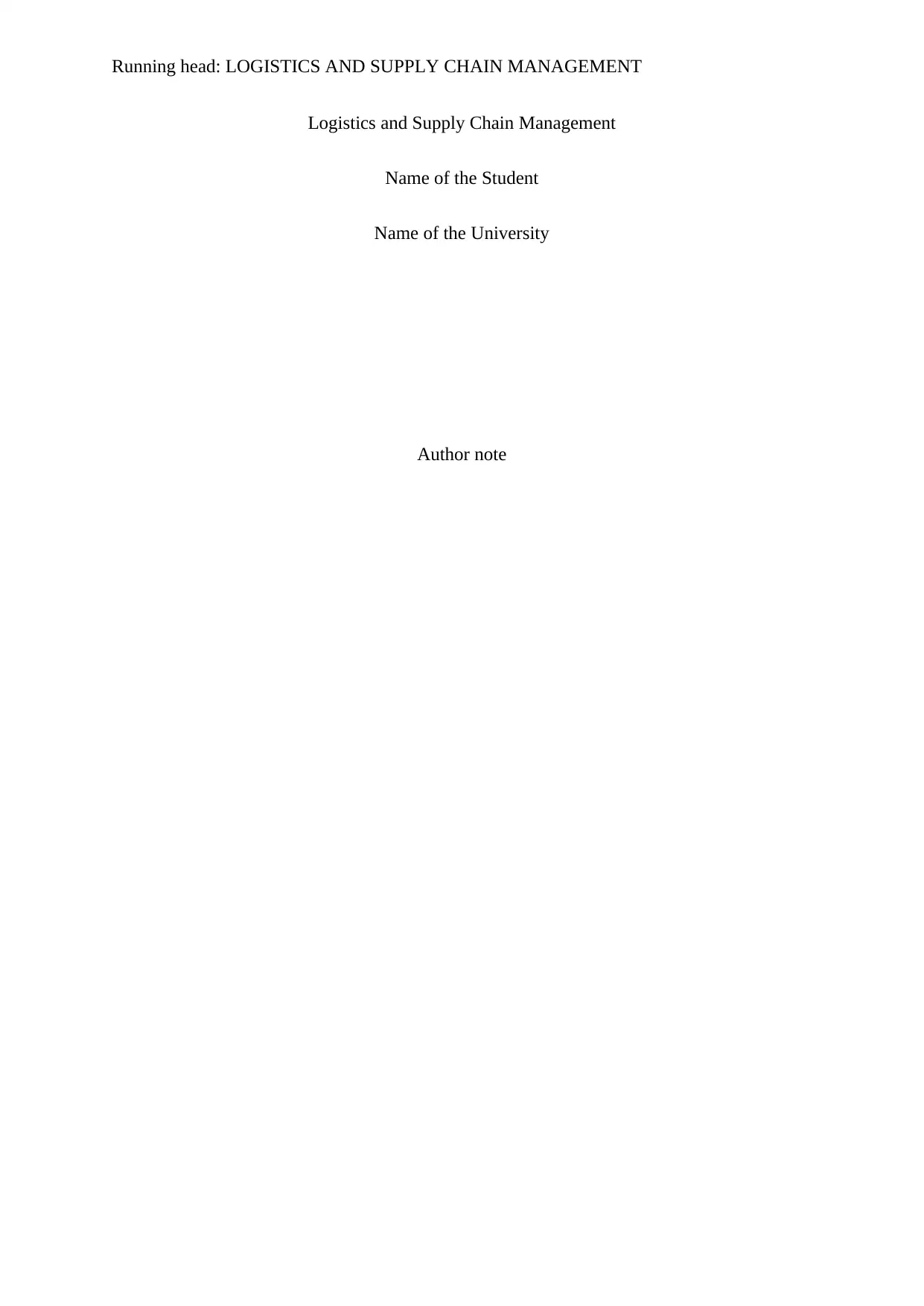
Running head: LOGISTICS AND SUPPLY CHAIN MANAGEMENT
Logistics and Supply Chain Management
Name of the Student
Name of the University
Author note
Logistics and Supply Chain Management
Name of the Student
Name of the University
Author note
Paraphrase This Document
Need a fresh take? Get an instant paraphrase of this document with our AI Paraphraser
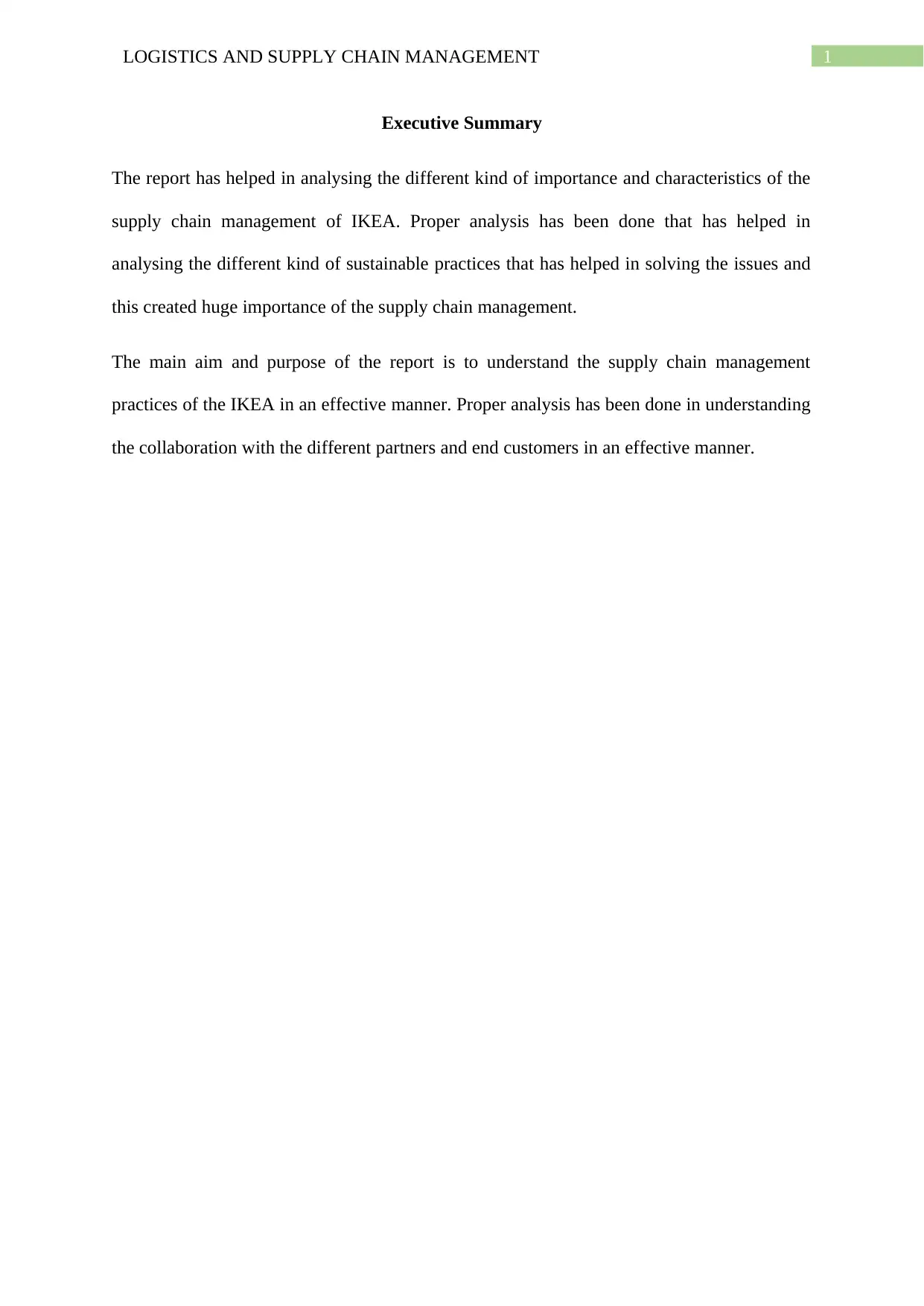
1LOGISTICS AND SUPPLY CHAIN MANAGEMENT
Executive Summary
The report has helped in analysing the different kind of importance and characteristics of the
supply chain management of IKEA. Proper analysis has been done that has helped in
analysing the different kind of sustainable practices that has helped in solving the issues and
this created huge importance of the supply chain management.
The main aim and purpose of the report is to understand the supply chain management
practices of the IKEA in an effective manner. Proper analysis has been done in understanding
the collaboration with the different partners and end customers in an effective manner.
Executive Summary
The report has helped in analysing the different kind of importance and characteristics of the
supply chain management of IKEA. Proper analysis has been done that has helped in
analysing the different kind of sustainable practices that has helped in solving the issues and
this created huge importance of the supply chain management.
The main aim and purpose of the report is to understand the supply chain management
practices of the IKEA in an effective manner. Proper analysis has been done in understanding
the collaboration with the different partners and end customers in an effective manner.
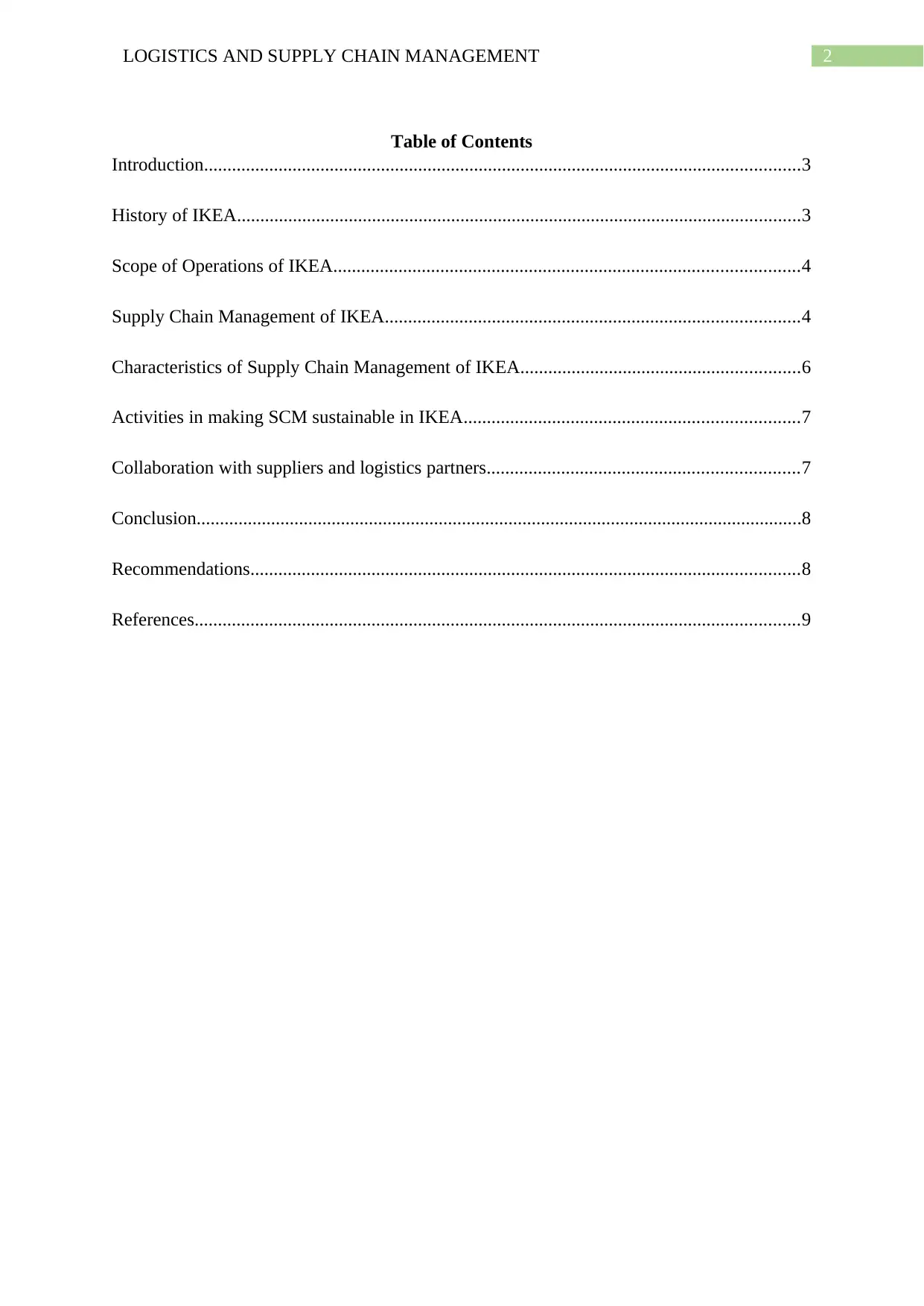
2LOGISTICS AND SUPPLY CHAIN MANAGEMENT
Table of Contents
Introduction................................................................................................................................3
History of IKEA.........................................................................................................................3
Scope of Operations of IKEA....................................................................................................4
Supply Chain Management of IKEA.........................................................................................4
Characteristics of Supply Chain Management of IKEA............................................................6
Activities in making SCM sustainable in IKEA........................................................................7
Collaboration with suppliers and logistics partners...................................................................7
Conclusion..................................................................................................................................8
Recommendations......................................................................................................................8
References..................................................................................................................................9
Table of Contents
Introduction................................................................................................................................3
History of IKEA.........................................................................................................................3
Scope of Operations of IKEA....................................................................................................4
Supply Chain Management of IKEA.........................................................................................4
Characteristics of Supply Chain Management of IKEA............................................................6
Activities in making SCM sustainable in IKEA........................................................................7
Collaboration with suppliers and logistics partners...................................................................7
Conclusion..................................................................................................................................8
Recommendations......................................................................................................................8
References..................................................................................................................................9
⊘ This is a preview!⊘
Do you want full access?
Subscribe today to unlock all pages.

Trusted by 1+ million students worldwide
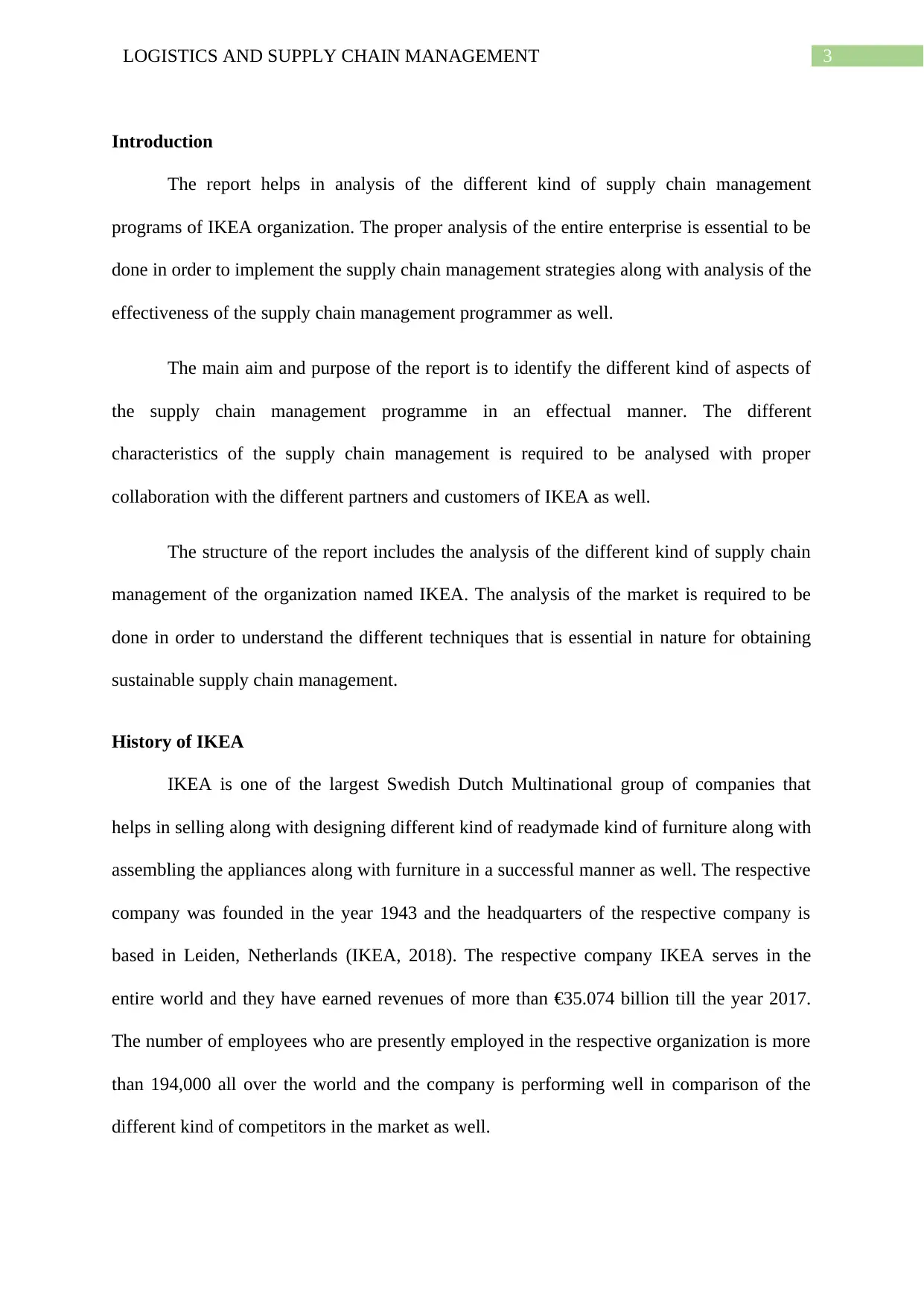
3LOGISTICS AND SUPPLY CHAIN MANAGEMENT
Introduction
The report helps in analysis of the different kind of supply chain management
programs of IKEA organization. The proper analysis of the entire enterprise is essential to be
done in order to implement the supply chain management strategies along with analysis of the
effectiveness of the supply chain management programmer as well.
The main aim and purpose of the report is to identify the different kind of aspects of
the supply chain management programme in an effectual manner. The different
characteristics of the supply chain management is required to be analysed with proper
collaboration with the different partners and customers of IKEA as well.
The structure of the report includes the analysis of the different kind of supply chain
management of the organization named IKEA. The analysis of the market is required to be
done in order to understand the different techniques that is essential in nature for obtaining
sustainable supply chain management.
History of IKEA
IKEA is one of the largest Swedish Dutch Multinational group of companies that
helps in selling along with designing different kind of readymade kind of furniture along with
assembling the appliances along with furniture in a successful manner as well. The respective
company was founded in the year 1943 and the headquarters of the respective company is
based in Leiden, Netherlands (IKEA, 2018). The respective company IKEA serves in the
entire world and they have earned revenues of more than €35.074 billion till the year 2017.
The number of employees who are presently employed in the respective organization is more
than 194,000 all over the world and the company is performing well in comparison of the
different kind of competitors in the market as well.
Introduction
The report helps in analysis of the different kind of supply chain management
programs of IKEA organization. The proper analysis of the entire enterprise is essential to be
done in order to implement the supply chain management strategies along with analysis of the
effectiveness of the supply chain management programmer as well.
The main aim and purpose of the report is to identify the different kind of aspects of
the supply chain management programme in an effectual manner. The different
characteristics of the supply chain management is required to be analysed with proper
collaboration with the different partners and customers of IKEA as well.
The structure of the report includes the analysis of the different kind of supply chain
management of the organization named IKEA. The analysis of the market is required to be
done in order to understand the different techniques that is essential in nature for obtaining
sustainable supply chain management.
History of IKEA
IKEA is one of the largest Swedish Dutch Multinational group of companies that
helps in selling along with designing different kind of readymade kind of furniture along with
assembling the appliances along with furniture in a successful manner as well. The respective
company was founded in the year 1943 and the headquarters of the respective company is
based in Leiden, Netherlands (IKEA, 2018). The respective company IKEA serves in the
entire world and they have earned revenues of more than €35.074 billion till the year 2017.
The number of employees who are presently employed in the respective organization is more
than 194,000 all over the world and the company is performing well in comparison of the
different kind of competitors in the market as well.
Paraphrase This Document
Need a fresh take? Get an instant paraphrase of this document with our AI Paraphraser
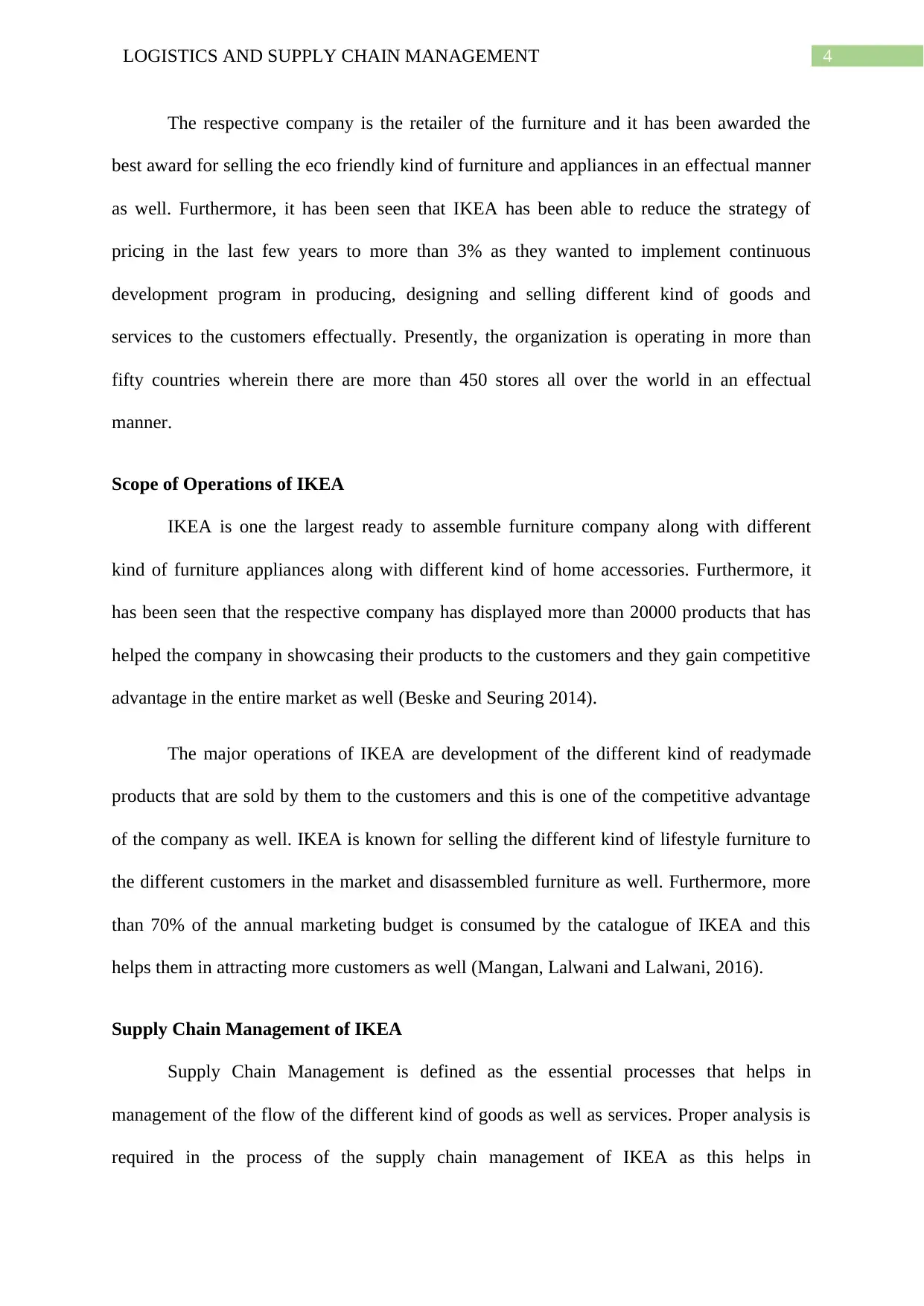
4LOGISTICS AND SUPPLY CHAIN MANAGEMENT
The respective company is the retailer of the furniture and it has been awarded the
best award for selling the eco friendly kind of furniture and appliances in an effectual manner
as well. Furthermore, it has been seen that IKEA has been able to reduce the strategy of
pricing in the last few years to more than 3% as they wanted to implement continuous
development program in producing, designing and selling different kind of goods and
services to the customers effectually. Presently, the organization is operating in more than
fifty countries wherein there are more than 450 stores all over the world in an effectual
manner.
Scope of Operations of IKEA
IKEA is one the largest ready to assemble furniture company along with different
kind of furniture appliances along with different kind of home accessories. Furthermore, it
has been seen that the respective company has displayed more than 20000 products that has
helped the company in showcasing their products to the customers and they gain competitive
advantage in the entire market as well (Beske and Seuring 2014).
The major operations of IKEA are development of the different kind of readymade
products that are sold by them to the customers and this is one of the competitive advantage
of the company as well. IKEA is known for selling the different kind of lifestyle furniture to
the different customers in the market and disassembled furniture as well. Furthermore, more
than 70% of the annual marketing budget is consumed by the catalogue of IKEA and this
helps them in attracting more customers as well (Mangan, Lalwani and Lalwani, 2016).
Supply Chain Management of IKEA
Supply Chain Management is defined as the essential processes that helps in
management of the flow of the different kind of goods as well as services. Proper analysis is
required in the process of the supply chain management of IKEA as this helps in
The respective company is the retailer of the furniture and it has been awarded the
best award for selling the eco friendly kind of furniture and appliances in an effectual manner
as well. Furthermore, it has been seen that IKEA has been able to reduce the strategy of
pricing in the last few years to more than 3% as they wanted to implement continuous
development program in producing, designing and selling different kind of goods and
services to the customers effectually. Presently, the organization is operating in more than
fifty countries wherein there are more than 450 stores all over the world in an effectual
manner.
Scope of Operations of IKEA
IKEA is one the largest ready to assemble furniture company along with different
kind of furniture appliances along with different kind of home accessories. Furthermore, it
has been seen that the respective company has displayed more than 20000 products that has
helped the company in showcasing their products to the customers and they gain competitive
advantage in the entire market as well (Beske and Seuring 2014).
The major operations of IKEA are development of the different kind of readymade
products that are sold by them to the customers and this is one of the competitive advantage
of the company as well. IKEA is known for selling the different kind of lifestyle furniture to
the different customers in the market and disassembled furniture as well. Furthermore, more
than 70% of the annual marketing budget is consumed by the catalogue of IKEA and this
helps them in attracting more customers as well (Mangan, Lalwani and Lalwani, 2016).
Supply Chain Management of IKEA
Supply Chain Management is defined as the essential processes that helps in
management of the flow of the different kind of goods as well as services. Proper analysis is
required in the process of the supply chain management of IKEA as this helps in
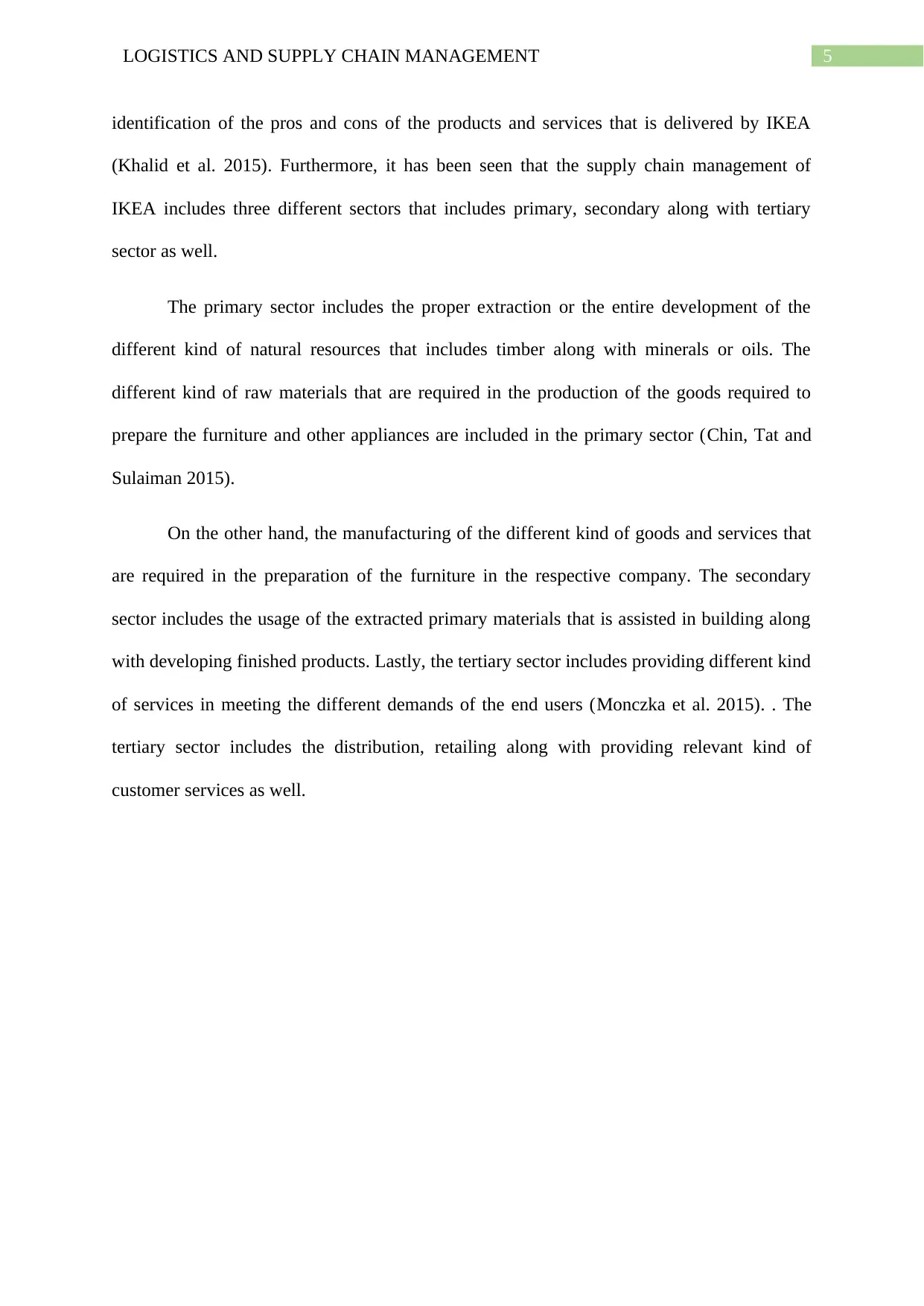
5LOGISTICS AND SUPPLY CHAIN MANAGEMENT
identification of the pros and cons of the products and services that is delivered by IKEA
(Khalid et al. 2015). Furthermore, it has been seen that the supply chain management of
IKEA includes three different sectors that includes primary, secondary along with tertiary
sector as well.
The primary sector includes the proper extraction or the entire development of the
different kind of natural resources that includes timber along with minerals or oils. The
different kind of raw materials that are required in the production of the goods required to
prepare the furniture and other appliances are included in the primary sector (Chin, Tat and
Sulaiman 2015).
On the other hand, the manufacturing of the different kind of goods and services that
are required in the preparation of the furniture in the respective company. The secondary
sector includes the usage of the extracted primary materials that is assisted in building along
with developing finished products. Lastly, the tertiary sector includes providing different kind
of services in meeting the different demands of the end users (Monczka et al. 2015). . The
tertiary sector includes the distribution, retailing along with providing relevant kind of
customer services as well.
identification of the pros and cons of the products and services that is delivered by IKEA
(Khalid et al. 2015). Furthermore, it has been seen that the supply chain management of
IKEA includes three different sectors that includes primary, secondary along with tertiary
sector as well.
The primary sector includes the proper extraction or the entire development of the
different kind of natural resources that includes timber along with minerals or oils. The
different kind of raw materials that are required in the production of the goods required to
prepare the furniture and other appliances are included in the primary sector (Chin, Tat and
Sulaiman 2015).
On the other hand, the manufacturing of the different kind of goods and services that
are required in the preparation of the furniture in the respective company. The secondary
sector includes the usage of the extracted primary materials that is assisted in building along
with developing finished products. Lastly, the tertiary sector includes providing different kind
of services in meeting the different demands of the end users (Monczka et al. 2015). . The
tertiary sector includes the distribution, retailing along with providing relevant kind of
customer services as well.
⊘ This is a preview!⊘
Do you want full access?
Subscribe today to unlock all pages.

Trusted by 1+ million students worldwide
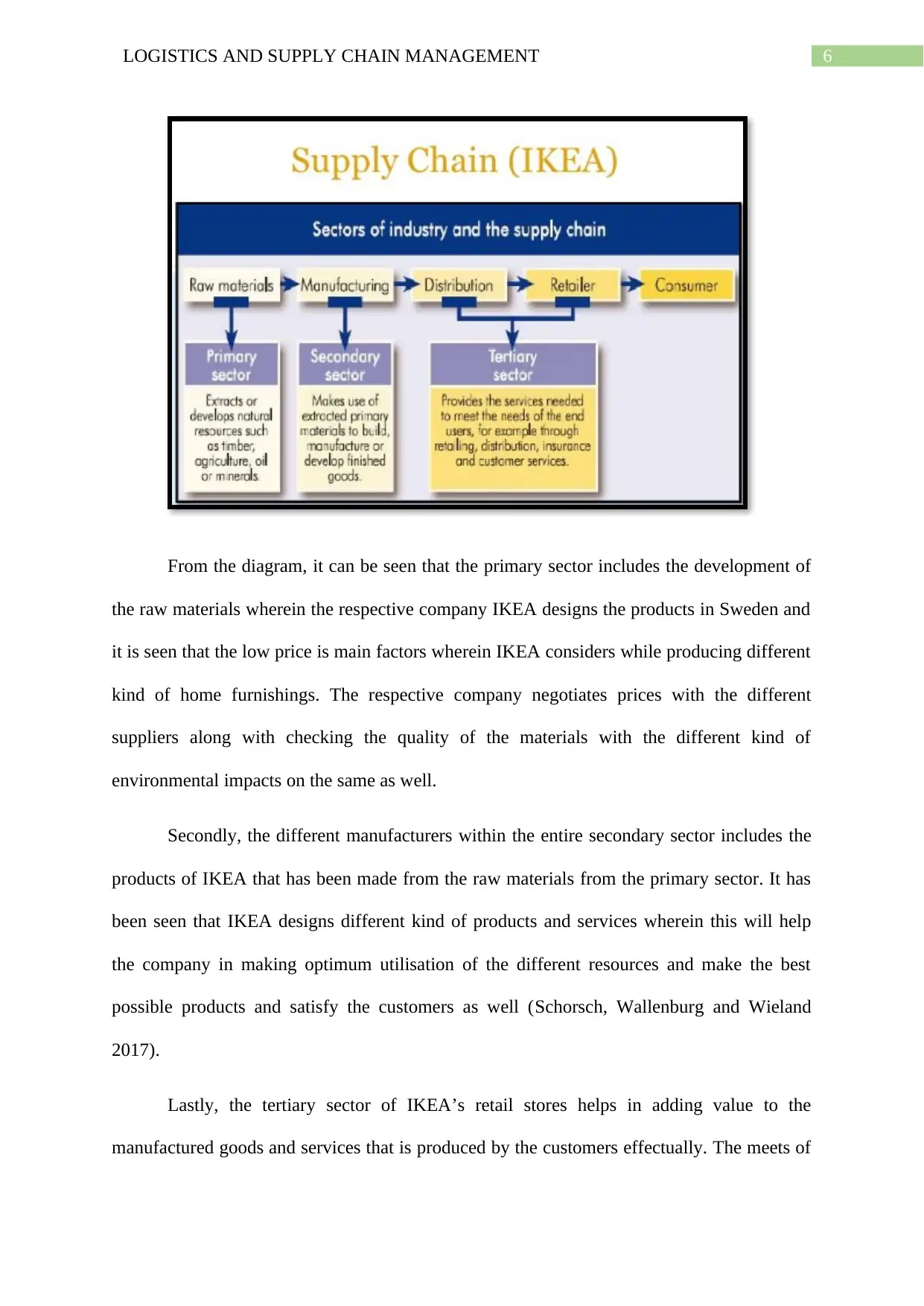
6LOGISTICS AND SUPPLY CHAIN MANAGEMENT
From the diagram, it can be seen that the primary sector includes the development of
the raw materials wherein the respective company IKEA designs the products in Sweden and
it is seen that the low price is main factors wherein IKEA considers while producing different
kind of home furnishings. The respective company negotiates prices with the different
suppliers along with checking the quality of the materials with the different kind of
environmental impacts on the same as well.
Secondly, the different manufacturers within the entire secondary sector includes the
products of IKEA that has been made from the raw materials from the primary sector. It has
been seen that IKEA designs different kind of products and services wherein this will help
the company in making optimum utilisation of the different resources and make the best
possible products and satisfy the customers as well (Schorsch, Wallenburg and Wieland
2017).
Lastly, the tertiary sector of IKEA’s retail stores helps in adding value to the
manufactured goods and services that is produced by the customers effectually. The meets of
From the diagram, it can be seen that the primary sector includes the development of
the raw materials wherein the respective company IKEA designs the products in Sweden and
it is seen that the low price is main factors wherein IKEA considers while producing different
kind of home furnishings. The respective company negotiates prices with the different
suppliers along with checking the quality of the materials with the different kind of
environmental impacts on the same as well.
Secondly, the different manufacturers within the entire secondary sector includes the
products of IKEA that has been made from the raw materials from the primary sector. It has
been seen that IKEA designs different kind of products and services wherein this will help
the company in making optimum utilisation of the different resources and make the best
possible products and satisfy the customers as well (Schorsch, Wallenburg and Wieland
2017).
Lastly, the tertiary sector of IKEA’s retail stores helps in adding value to the
manufactured goods and services that is produced by the customers effectually. The meets of
Paraphrase This Document
Need a fresh take? Get an instant paraphrase of this document with our AI Paraphraser
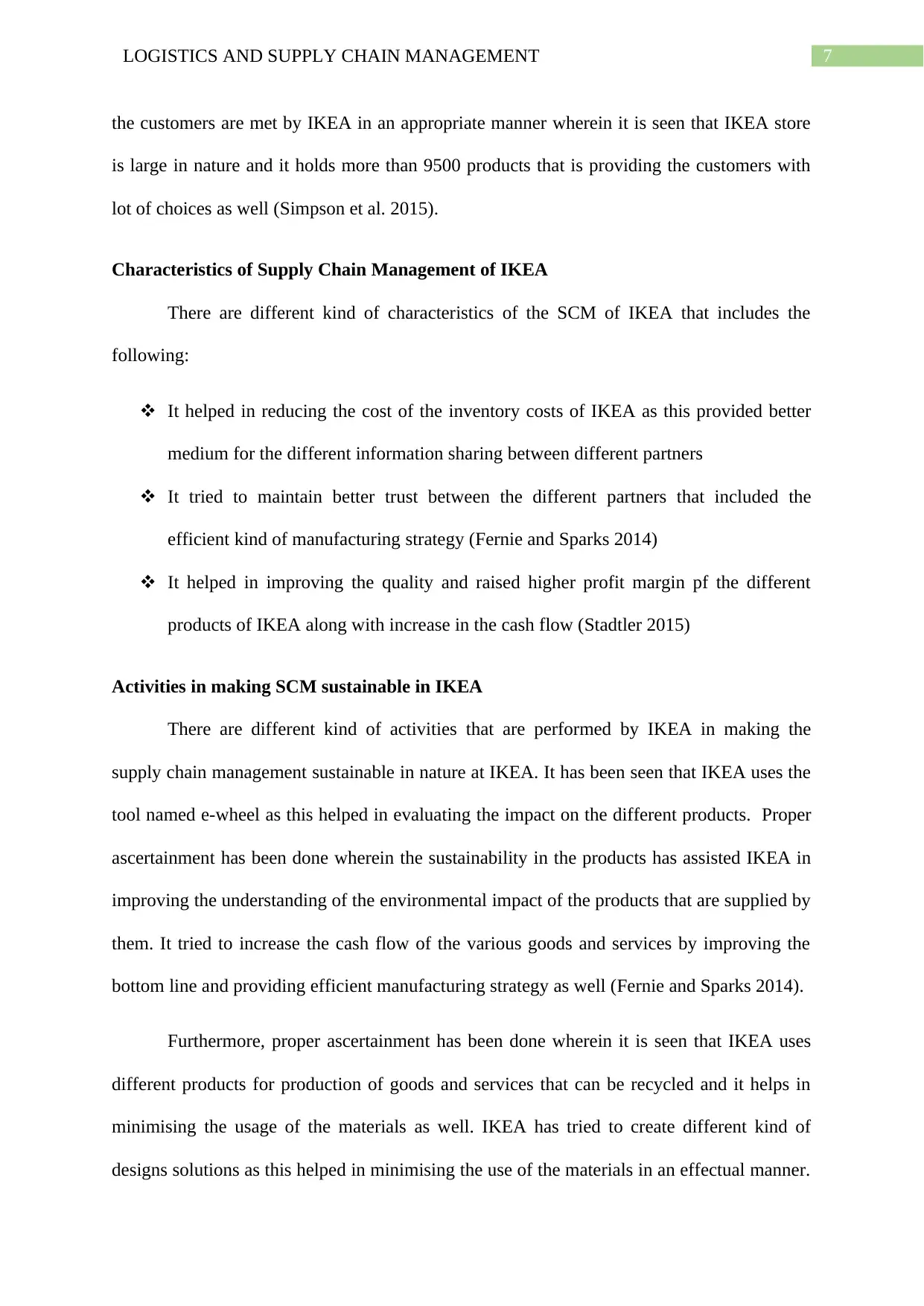
7LOGISTICS AND SUPPLY CHAIN MANAGEMENT
the customers are met by IKEA in an appropriate manner wherein it is seen that IKEA store
is large in nature and it holds more than 9500 products that is providing the customers with
lot of choices as well (Simpson et al. 2015).
Characteristics of Supply Chain Management of IKEA
There are different kind of characteristics of the SCM of IKEA that includes the
following:
It helped in reducing the cost of the inventory costs of IKEA as this provided better
medium for the different information sharing between different partners
It tried to maintain better trust between the different partners that included the
efficient kind of manufacturing strategy (Fernie and Sparks 2014)
It helped in improving the quality and raised higher profit margin pf the different
products of IKEA along with increase in the cash flow (Stadtler 2015)
Activities in making SCM sustainable in IKEA
There are different kind of activities that are performed by IKEA in making the
supply chain management sustainable in nature at IKEA. It has been seen that IKEA uses the
tool named e-wheel as this helped in evaluating the impact on the different products. Proper
ascertainment has been done wherein the sustainability in the products has assisted IKEA in
improving the understanding of the environmental impact of the products that are supplied by
them. It tried to increase the cash flow of the various goods and services by improving the
bottom line and providing efficient manufacturing strategy as well (Fernie and Sparks 2014).
Furthermore, proper ascertainment has been done wherein it is seen that IKEA uses
different products for production of goods and services that can be recycled and it helps in
minimising the usage of the materials as well. IKEA has tried to create different kind of
designs solutions as this helped in minimising the use of the materials in an effectual manner.
the customers are met by IKEA in an appropriate manner wherein it is seen that IKEA store
is large in nature and it holds more than 9500 products that is providing the customers with
lot of choices as well (Simpson et al. 2015).
Characteristics of Supply Chain Management of IKEA
There are different kind of characteristics of the SCM of IKEA that includes the
following:
It helped in reducing the cost of the inventory costs of IKEA as this provided better
medium for the different information sharing between different partners
It tried to maintain better trust between the different partners that included the
efficient kind of manufacturing strategy (Fernie and Sparks 2014)
It helped in improving the quality and raised higher profit margin pf the different
products of IKEA along with increase in the cash flow (Stadtler 2015)
Activities in making SCM sustainable in IKEA
There are different kind of activities that are performed by IKEA in making the
supply chain management sustainable in nature at IKEA. It has been seen that IKEA uses the
tool named e-wheel as this helped in evaluating the impact on the different products. Proper
ascertainment has been done wherein the sustainability in the products has assisted IKEA in
improving the understanding of the environmental impact of the products that are supplied by
them. It tried to increase the cash flow of the various goods and services by improving the
bottom line and providing efficient manufacturing strategy as well (Fernie and Sparks 2014).
Furthermore, proper ascertainment has been done wherein it is seen that IKEA uses
different products for production of goods and services that can be recycled and it helps in
minimising the usage of the materials as well. IKEA has tried to create different kind of
designs solutions as this helped in minimising the use of the materials in an effectual manner.
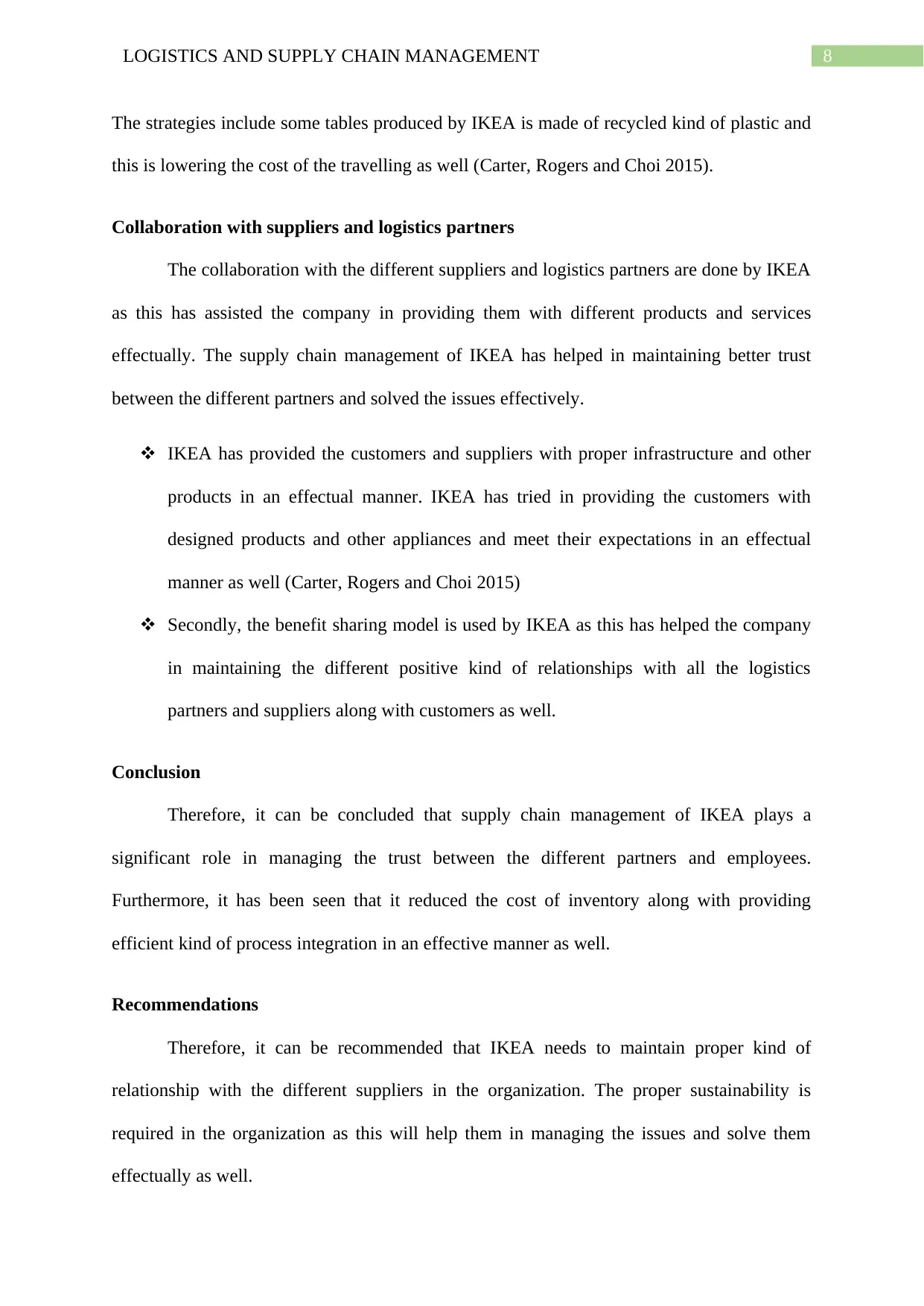
8LOGISTICS AND SUPPLY CHAIN MANAGEMENT
The strategies include some tables produced by IKEA is made of recycled kind of plastic and
this is lowering the cost of the travelling as well (Carter, Rogers and Choi 2015).
Collaboration with suppliers and logistics partners
The collaboration with the different suppliers and logistics partners are done by IKEA
as this has assisted the company in providing them with different products and services
effectually. The supply chain management of IKEA has helped in maintaining better trust
between the different partners and solved the issues effectively.
IKEA has provided the customers and suppliers with proper infrastructure and other
products in an effectual manner. IKEA has tried in providing the customers with
designed products and other appliances and meet their expectations in an effectual
manner as well (Carter, Rogers and Choi 2015)
Secondly, the benefit sharing model is used by IKEA as this has helped the company
in maintaining the different positive kind of relationships with all the logistics
partners and suppliers along with customers as well.
Conclusion
Therefore, it can be concluded that supply chain management of IKEA plays a
significant role in managing the trust between the different partners and employees.
Furthermore, it has been seen that it reduced the cost of inventory along with providing
efficient kind of process integration in an effective manner as well.
Recommendations
Therefore, it can be recommended that IKEA needs to maintain proper kind of
relationship with the different suppliers in the organization. The proper sustainability is
required in the organization as this will help them in managing the issues and solve them
effectually as well.
The strategies include some tables produced by IKEA is made of recycled kind of plastic and
this is lowering the cost of the travelling as well (Carter, Rogers and Choi 2015).
Collaboration with suppliers and logistics partners
The collaboration with the different suppliers and logistics partners are done by IKEA
as this has assisted the company in providing them with different products and services
effectually. The supply chain management of IKEA has helped in maintaining better trust
between the different partners and solved the issues effectively.
IKEA has provided the customers and suppliers with proper infrastructure and other
products in an effectual manner. IKEA has tried in providing the customers with
designed products and other appliances and meet their expectations in an effectual
manner as well (Carter, Rogers and Choi 2015)
Secondly, the benefit sharing model is used by IKEA as this has helped the company
in maintaining the different positive kind of relationships with all the logistics
partners and suppliers along with customers as well.
Conclusion
Therefore, it can be concluded that supply chain management of IKEA plays a
significant role in managing the trust between the different partners and employees.
Furthermore, it has been seen that it reduced the cost of inventory along with providing
efficient kind of process integration in an effective manner as well.
Recommendations
Therefore, it can be recommended that IKEA needs to maintain proper kind of
relationship with the different suppliers in the organization. The proper sustainability is
required in the organization as this will help them in managing the issues and solve them
effectually as well.
⊘ This is a preview!⊘
Do you want full access?
Subscribe today to unlock all pages.

Trusted by 1+ million students worldwide
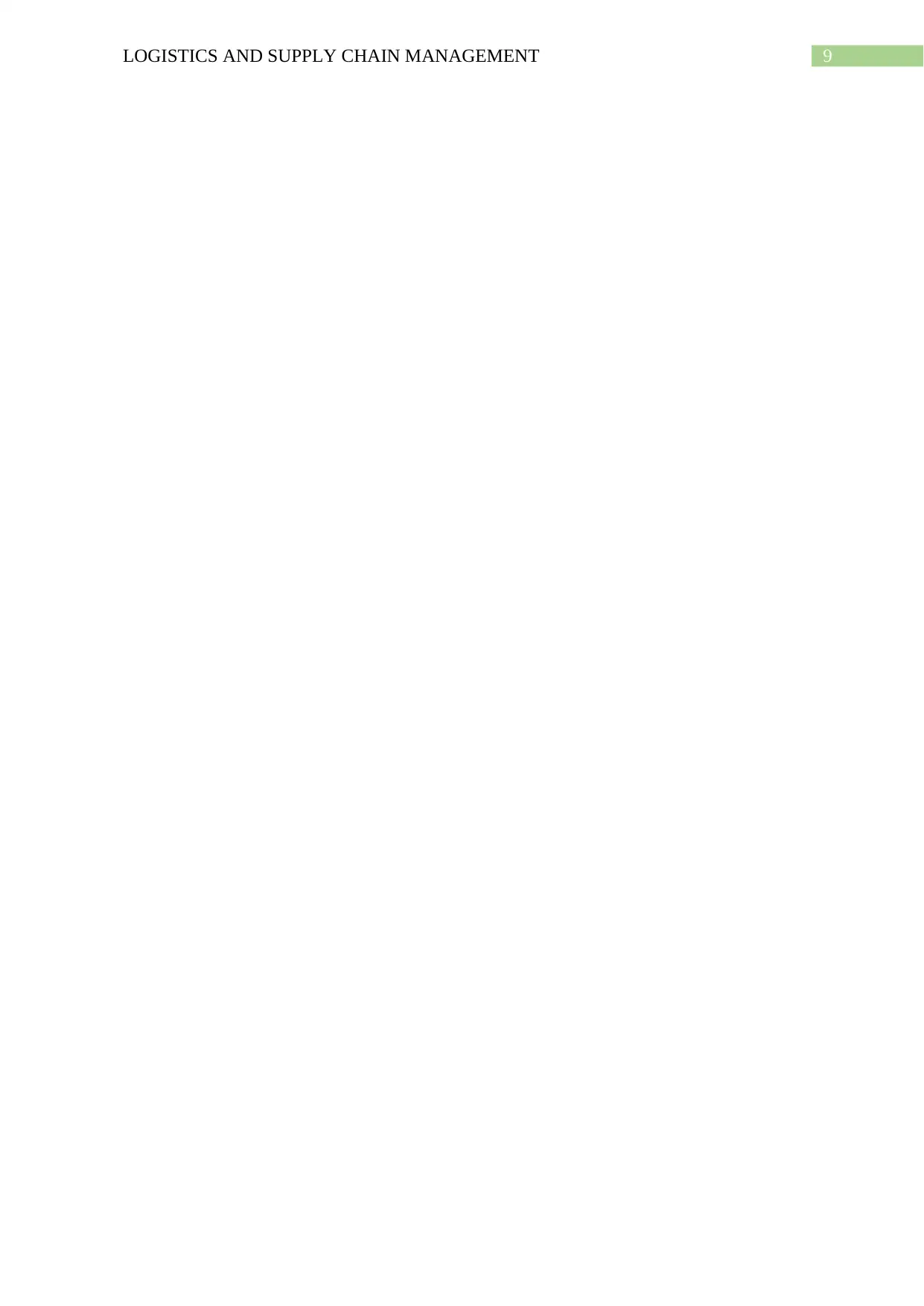
9LOGISTICS AND SUPPLY CHAIN MANAGEMENT
Paraphrase This Document
Need a fresh take? Get an instant paraphrase of this document with our AI Paraphraser
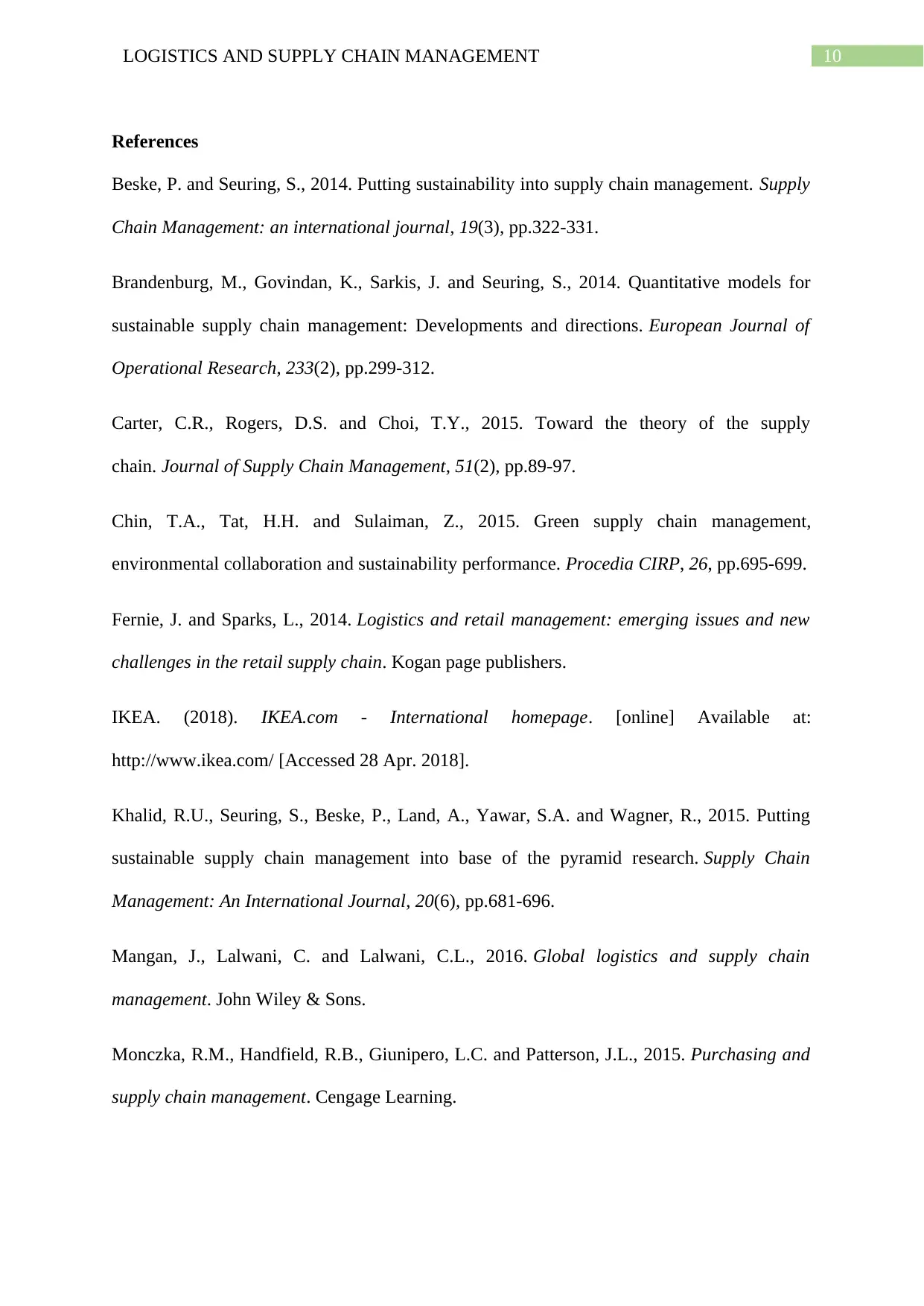
10LOGISTICS AND SUPPLY CHAIN MANAGEMENT
References
Beske, P. and Seuring, S., 2014. Putting sustainability into supply chain management. Supply
Chain Management: an international journal, 19(3), pp.322-331.
Brandenburg, M., Govindan, K., Sarkis, J. and Seuring, S., 2014. Quantitative models for
sustainable supply chain management: Developments and directions. European Journal of
Operational Research, 233(2), pp.299-312.
Carter, C.R., Rogers, D.S. and Choi, T.Y., 2015. Toward the theory of the supply
chain. Journal of Supply Chain Management, 51(2), pp.89-97.
Chin, T.A., Tat, H.H. and Sulaiman, Z., 2015. Green supply chain management,
environmental collaboration and sustainability performance. Procedia CIRP, 26, pp.695-699.
Fernie, J. and Sparks, L., 2014. Logistics and retail management: emerging issues and new
challenges in the retail supply chain. Kogan page publishers.
IKEA. (2018). IKEA.com - International homepage. [online] Available at:
http://www.ikea.com/ [Accessed 28 Apr. 2018].
Khalid, R.U., Seuring, S., Beske, P., Land, A., Yawar, S.A. and Wagner, R., 2015. Putting
sustainable supply chain management into base of the pyramid research. Supply Chain
Management: An International Journal, 20(6), pp.681-696.
Mangan, J., Lalwani, C. and Lalwani, C.L., 2016. Global logistics and supply chain
management. John Wiley & Sons.
Monczka, R.M., Handfield, R.B., Giunipero, L.C. and Patterson, J.L., 2015. Purchasing and
supply chain management. Cengage Learning.
References
Beske, P. and Seuring, S., 2014. Putting sustainability into supply chain management. Supply
Chain Management: an international journal, 19(3), pp.322-331.
Brandenburg, M., Govindan, K., Sarkis, J. and Seuring, S., 2014. Quantitative models for
sustainable supply chain management: Developments and directions. European Journal of
Operational Research, 233(2), pp.299-312.
Carter, C.R., Rogers, D.S. and Choi, T.Y., 2015. Toward the theory of the supply
chain. Journal of Supply Chain Management, 51(2), pp.89-97.
Chin, T.A., Tat, H.H. and Sulaiman, Z., 2015. Green supply chain management,
environmental collaboration and sustainability performance. Procedia CIRP, 26, pp.695-699.
Fernie, J. and Sparks, L., 2014. Logistics and retail management: emerging issues and new
challenges in the retail supply chain. Kogan page publishers.
IKEA. (2018). IKEA.com - International homepage. [online] Available at:
http://www.ikea.com/ [Accessed 28 Apr. 2018].
Khalid, R.U., Seuring, S., Beske, P., Land, A., Yawar, S.A. and Wagner, R., 2015. Putting
sustainable supply chain management into base of the pyramid research. Supply Chain
Management: An International Journal, 20(6), pp.681-696.
Mangan, J., Lalwani, C. and Lalwani, C.L., 2016. Global logistics and supply chain
management. John Wiley & Sons.
Monczka, R.M., Handfield, R.B., Giunipero, L.C. and Patterson, J.L., 2015. Purchasing and
supply chain management. Cengage Learning.
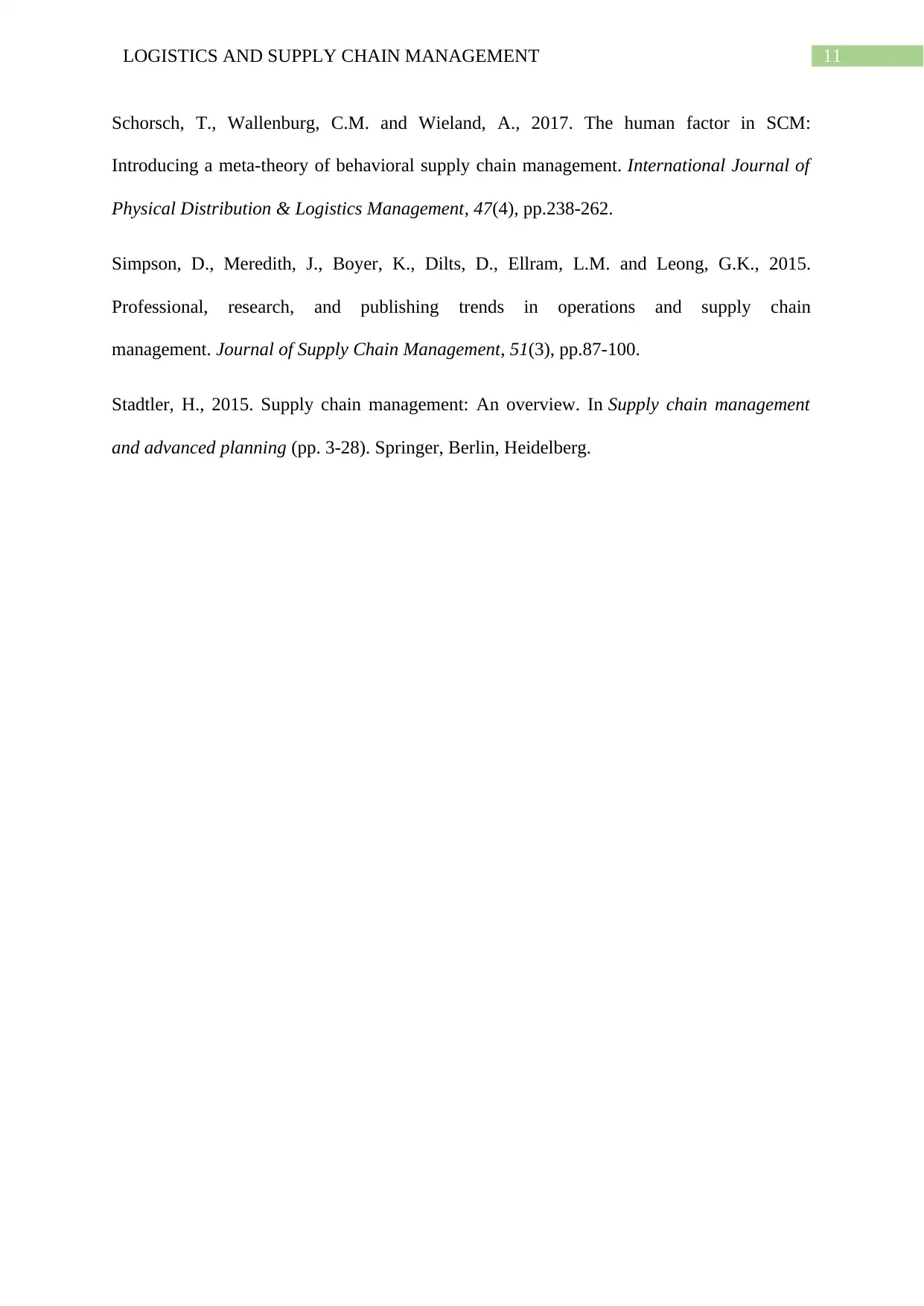
11LOGISTICS AND SUPPLY CHAIN MANAGEMENT
Schorsch, T., Wallenburg, C.M. and Wieland, A., 2017. The human factor in SCM:
Introducing a meta-theory of behavioral supply chain management. International Journal of
Physical Distribution & Logistics Management, 47(4), pp.238-262.
Simpson, D., Meredith, J., Boyer, K., Dilts, D., Ellram, L.M. and Leong, G.K., 2015.
Professional, research, and publishing trends in operations and supply chain
management. Journal of Supply Chain Management, 51(3), pp.87-100.
Stadtler, H., 2015. Supply chain management: An overview. In Supply chain management
and advanced planning (pp. 3-28). Springer, Berlin, Heidelberg.
Schorsch, T., Wallenburg, C.M. and Wieland, A., 2017. The human factor in SCM:
Introducing a meta-theory of behavioral supply chain management. International Journal of
Physical Distribution & Logistics Management, 47(4), pp.238-262.
Simpson, D., Meredith, J., Boyer, K., Dilts, D., Ellram, L.M. and Leong, G.K., 2015.
Professional, research, and publishing trends in operations and supply chain
management. Journal of Supply Chain Management, 51(3), pp.87-100.
Stadtler, H., 2015. Supply chain management: An overview. In Supply chain management
and advanced planning (pp. 3-28). Springer, Berlin, Heidelberg.
⊘ This is a preview!⊘
Do you want full access?
Subscribe today to unlock all pages.

Trusted by 1+ million students worldwide
1 out of 12
Related Documents
Your All-in-One AI-Powered Toolkit for Academic Success.
+13062052269
info@desklib.com
Available 24*7 on WhatsApp / Email
![[object Object]](/_next/static/media/star-bottom.7253800d.svg)
Unlock your academic potential
Copyright © 2020–2025 A2Z Services. All Rights Reserved. Developed and managed by ZUCOL.



